Mad March
Tuesday, March 27, 2012
Apologies for the delay in posting March News due to problems
with our site.
Honestly, you would not believe it! I have just read last years
March News and this month has been an exact replica. Only
difference is that it has been warmer. We have had no drought here
thank goodness but we could do with some rain soon as the rivers
have already dropped to levels you don't expect in March.
If you want to know what this month has been like. read March
2011 News! Seriously it is difficult to find much that is different
to say. But isn't that like gardening or even life itself? There is
a pattern and rhythm to life wherever we live but especially in the
countryside where the seasons are more keenly felt. If you miss a
point on the wheel in the turning year you can never catch up so
the tasks remain the same, affected only by the vagaries of the
weather and our own planning. We are really on top of things this
year, well ahead of where we usually are and Moira is so pleased
that she has has completed her marathon painting efforts on the
house and in the gardens. Retirement makes this all possible
but we still wonder how we managed to do all this whilst we were
still working.
Weather Report
Only 2 minor frosts to -2C in mid month, little rain and hot
sunshine for the last 9 days with a max of 21C. No March winds for
the second year in succession and hope we don't suffer for this
balmy weather later this Spring
Garden Update
Seed sowing continues with 180 varieties sown already and all
the more tender/late flowering stuff to sow during April. We have
started the mammoth task of potting on established plants and
pricking out seedlings and already space is at a premium in
tunnels, greenhouses and frames. Stock management, moving plants
between them and outoor benching is a continuous undertaking to
ensure we have sufficient space and the right environments for our
more delicate seedlings.
A bench full of pricked out seedlings
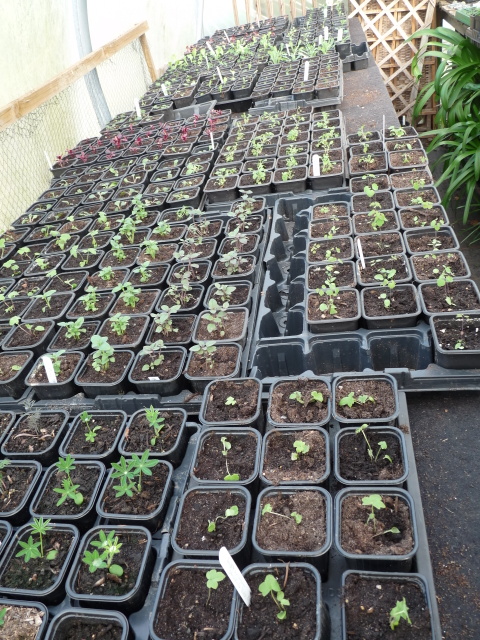
The borders have all been cut back and we have started to turn
them over and thin/replant those that have become tired or outgrown
their space - campanula family, asters and monardas step forward
please - some of them are real thugs!! They do however provide new
plants for the nursery - that's the beauty of perennial hardy
plants.
Parts of the Paddock Garden lawn have looked poor for some time
with patches of dead grass. Heavy thatch rather than pests or
diseases seems to have been the problem so I spent a couple of days
recently scarifying this lawn and carted 24 wheelbarrow loads of
dead stuff from just 400 sq. metres. True the lawn looks a bit
sorry for itself now but I am assured by a golf course greenkeeper
acquaintance of mine that they will be all the better for it. I
know it is not particularly fashionable but I do like a good, weed
free lawn to set off the borders.
Not a pretty sight - the lawn scarified to death!! Now
top dressed and grass seed sown. Hope I will have better news
in a couple of months time. watch this space.
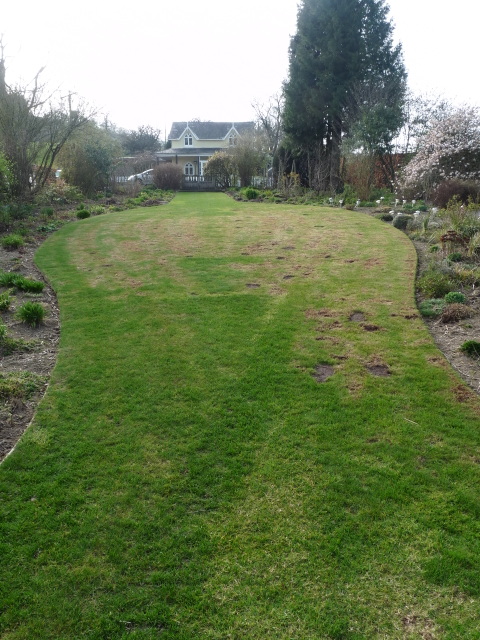
Having turned over the veg garden, the spuds and onions are
already in, and if the current weather continues will get the small
seeds like carrots parsnips and beetroot sown. Exciting time of
year.
As an old fashioned gardener I am finding it difficult to
come to terms with the reduction of peat in growing mediums
(potting composts). It means having to rethink watering regimes in
particular and I know that many amateur gardeners like me as well
as some major national nurseries are finding similar challenges. If
current government driven peat reduction targets are to met by
2020. however unlikely that may be to achieve. we will all have to
get used to it. What will help us to do so is top quality reduced
peat products. In this respect I must say that, even though it
varies from batch to batch, the quality of the J A Bowers Multi
Purpose Compost I have used this year has been exceptionally good -
a nice open coarse mix, including recycled materials and wood
shreddings, which like peat drains well but retains some moisture.
Early results are encouraging. However I have encountered other
peat free products. which have contained broken glass, electrical
wires, shreds of rubber, china and large chunks of wood. No wonder
the instructions for use of the compost direct the use of stout
gloves. I am sure it won't be long before I find something really
unpleasant or dangerous.
What's looking good?
It's good to see so much emerging growth on trees, shrubs and
perennial plants. The hot weather hasn't agreed though with early
spring flowering plants - the hellebores are finishing quickly and
the narcissus seem to have been here and gone in no time. They
haven't been as floriferous as in previous years.
I am very pleased however that early euphorbias have done well
and thanks to the absence of frosts we have e.characias
wulfeni and e. martinii "Ascot Variegated" currently in flower in
addition to e. myrsinites a low growing form which is a very
reliable flowerer whatever the weather.
Euphorbias "Ascot Rainbow"on the left and
characiaswulfeni on the right
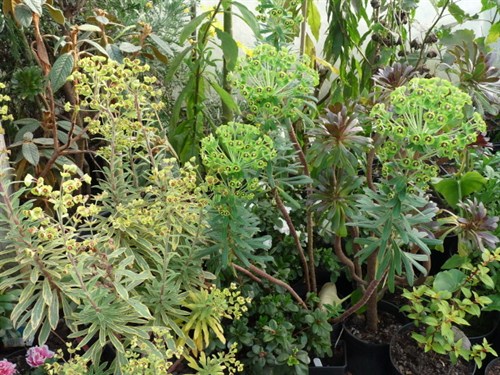
Low growing euphorbia myrsinites

In the tunnels the star performers are zantedeshcia aethiopica
"White Sail", a shorter form than the type with large lipped
flowers, clianthus puniceus the so called lobster claw, a shrub
from New Zealand and borderline hardy. and the slightly tender
coronilla glauca a scented pea family member.
Zantedeschia "White Sail"
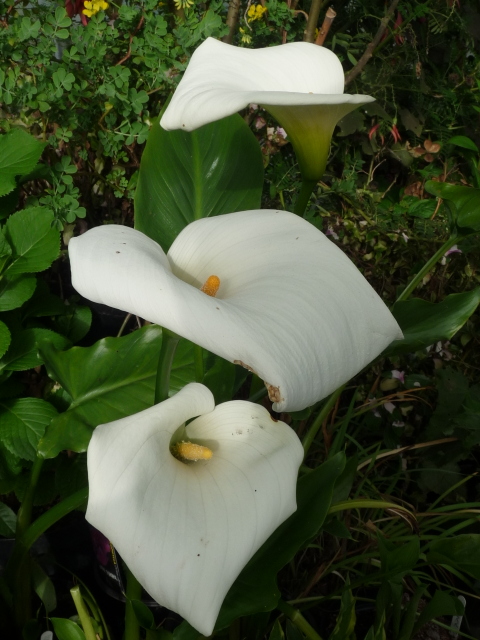
The "lobster claw" clianthus puniceus with its wildly
exotice flowers. It is just about hardy in the right spot
particularly if grown as a south facing wall shrub as seen at
Marwood Hill Gardens Barnstaple, Devon in 2007. Ours shown here
needs polytunnel protection. There is also a white flowered
form

The flowers on the pieris have been especially good this
year and in the warm weather I have been surprised how pleasantly
scented they are - slightly sweet with a hint a
vanilla.
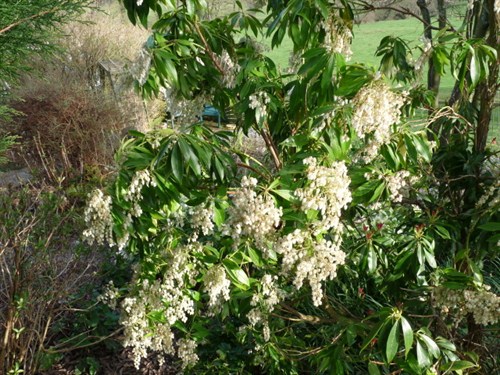
Outside in a sheltered location is a fine stand of
cyclamen repandum, an attractive spring flowering reasonably hardy
species form that has clumped up well alongside a cold frame where
it started life but has seeded itself around.
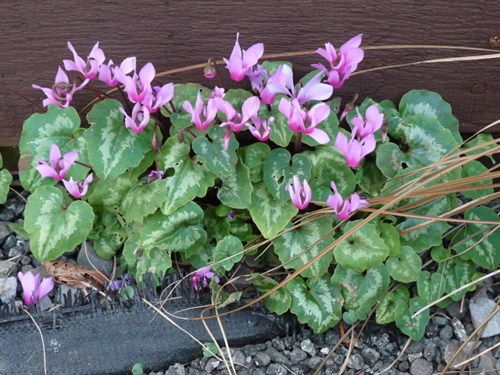
I hope it isn't tempting fate to say so but of the 180 or so
pots of seedlings there hasn't been a single case of damping off in
any of them. This is due in part to being able to fully ventilate
the propogation tunnel on most days and perhaps the use of a
preventative treatment called Bayer Disease Control which seems
more effective that the Cheshunt compound I have used for many
years.
Finally it is great to see the clematis into good
growth, with the alpinas and macropetalas now in bud, the first one
to flower was C. alpina "Frances Rivis" in a good shade of blue
weaving its way through the skeleton of a rhododendron which it
shares wiith a silver owl. There is magic everywhere at Cilgwyn
Lodge!
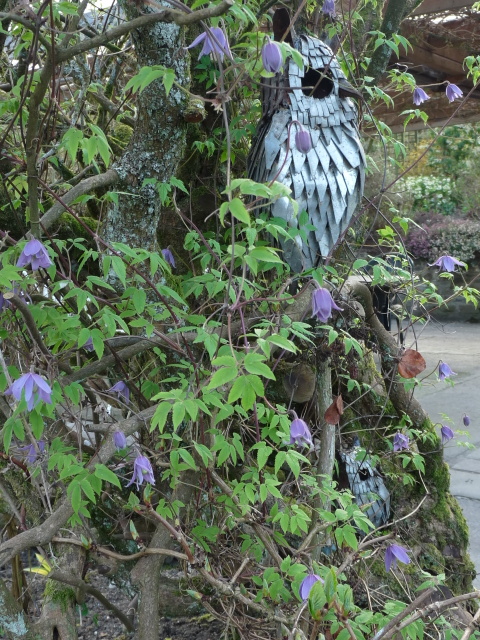
Wildlife and countryside
All the amphibians have now "done their stuff" in the Paddock
Pond, toads and newts much fewer in number than the frogs. It
always amazes me how far such small creatures as newts will travel
to get to the pond. We find them almost emaciated all over the
garden yet when they get to the water they just spring to life.
Also springing to life are the wood anemones along the shady
road verges and river banks, often together with primroses which
are having a fantastic year. A few bluebells too at least a month
ahead of their normal flowering time.
It worries me that I have not seen a single robin in the garden
for at least 2 months. They are usually my constant companions
wherever I am working in the gardens. It puzzles me where they have
gone. I do however have the blackbirds for company especially my
old friend with the mallen streak. He is impossible to photograph
so you will have to take my word for his markings.
Probably the wildlife sight and sound of the month was the sight
of 2 buzzards mobbing a goshawk - they wouldn't have been so bold
had they been on their own. We once witnessed a goshawk take a
buzzard in mid air but the lucky buzzard was just too big for the
goshawk to carry off and it fell to earth when the goshawk dropped
it. The buzzard survived but it was pretty shook up.
Visits
The talks season has continued with 5 talks at St Clears,
Reynaldston, Kidwelly, Carmarthen and our home club at Llangadog.
Enthusiastic audiences and good participation. The most requested
talk of the winter was Designing with Perennials, our newest talk
which has a great deal of detail in it - far too much for a one
hour presentation.
I need to deliver a talk at leat 6 times to get a feel of it and
to make amendments (even some great composers did this with their
major works - not that I am comparing myself with them!!). I have
therefore reduced the slides in my Designing with Perennials talk
by 25, because it was just too long and I am in the process of
developing an new talk featuring hardy herbaceous perennials in
their own right, which with all the practice and knowledge I have
acquired over the last 30 years, I should have done a long time
ago. The new talk with appropriate title should be ready for next
winters talks programme.
On 31 March we went to a Plant Fair held by the Somerset Group
of the Hardy Plant Society at East Lambrook Manor, the former
garden of Margery Fish, a notable plantswoman. It still retains its
cottage garden feel but a cold day was not perhaps the best time to
enjoy its charms although there were many fine hellebores still to
admire.
The Manor House at East Lambrook
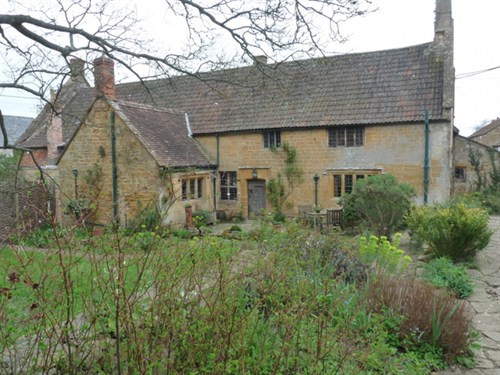
Cilgwyn Lodge Gardens
Although the gardens will not be open to vistors until mid
August, the nursery is open for plant sales but please ring us to
confirm we will be around when you would like to visit. There is a
very good range of herbaceous perennials available and some
clematis for sale.